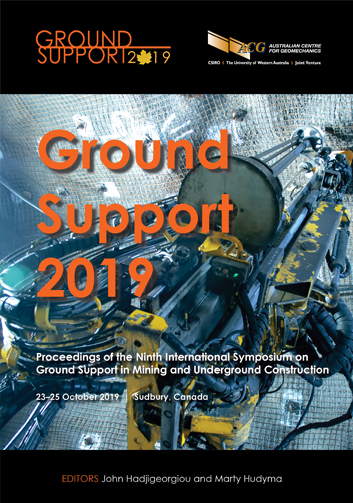Mechanised installation of rolled high tensile strength steel wire mesh for ground support: Canadian trial observations

|
Authors: Pritchard, C; Rorem, E; Landry, D; Whitmell, B |
DOI https://doi.org/10.36487/ACG_rep/1925_18_Pritchard
Cite As:
Pritchard, C, Rorem, E, Landry, D & Whitmell, B 2019, 'Mechanised installation of rolled high tensile strength steel wire mesh for ground support: Canadian trial observations', in J Hadjigeorgiou & M Hudyma (eds), Ground Support 2019: Proceedings of the Ninth International Symposium on Ground Support in Mining and Underground Construction, Australian Centre for Geomechanics, Perth, pp. 277-282, https://doi.org/10.36487/ACG_rep/1925_18_Pritchard
Abstract:
Rolled high tensile strength steel wire mesh for above-ground surface retention of landslides, oversteepened slopes, pit slopes and roadway exposures has been used globally for decades with high success and has become a standard of practice. Underground mining applications of the Geobrugg rolled mesh are now being used internationally in major block caving and other mining operations with good success and with well-documented performance tests. (Bucher et al. 2013) Furthermore, several other mine site-specific evaluations of cycle-time have documented efficiency improvements (Tonkin 2011). Canadian mines are seeing the need for improved surface support as mining depth increases. A working site evaluation of the rolled mesh is underway at an underground mine in Sudbury, Ontario. Here, a lighter version rolled mesh is being mechanically installed with an Epiroc Boltec boom bolter fitted with an unrolling device on the screen-handling boom. The first phase of this evaluation is intended to provide proof of concept specific to the mine. Key performance indicators are operator hazard exposure, cycle times and other efficiency measures, such as drilling time requirements, consumption of rockbolts, mesh, shotcrete and corrosion resistance, post-blast rehab requirements other effects on operations have been documented. The MINAX® 80-3 mesh used thus far is a lighter version intended for gravity conditions. A heavier version MINAX® 80-4 mesh is ideal for high-stress and bursting ground conditions and will be tried later after this initial proof of concept. An additional consideration was to be able to prove that mild steel galvanised welded wire mesh (GWWM), or sheet mesh could still be installed on the blasted face with the same machine setup as for the rolled mesh. All indications thus far are that the mesh and mesh installation represent a viable alternative to current surface support processes, which can improve both safety and efficiency of operations at the minimum while providing the opportunity for improved surface support performance in high-stress ground conditions. The initial results and observations of this first Canadian evaluation of the high tensile rolled mesh will be reported when complete.
Keywords: wire roll mesh, dynamic surface support, mechanised roll mesh installer
References:
Louchnikov, V, Sandy, MP, Watson, O, Orunesu, M & Eremenko, V 2014, ‘An overview of surface rock support for deformable ground conditions’, Proceedings of the 12th AusIMM Underground Operators’ Conference, The Australasian Institute of Mining and Metallurgy, Melbourne.
Tonkin, CJ 2011, Time and Motion Study of Sheeted Wire Meshing and Rolled Wire Mesh Systems. Goldfields: South Deep, University of Pretoria, Pretoria.
© Copyright 2025, Australian Centre for Geomechanics (ACG), The University of Western Australia. All rights reserved.
View copyright/legal information
Please direct any queries or error reports to repository-acg@uwa.edu.au
View copyright/legal information
Please direct any queries or error reports to repository-acg@uwa.edu.au